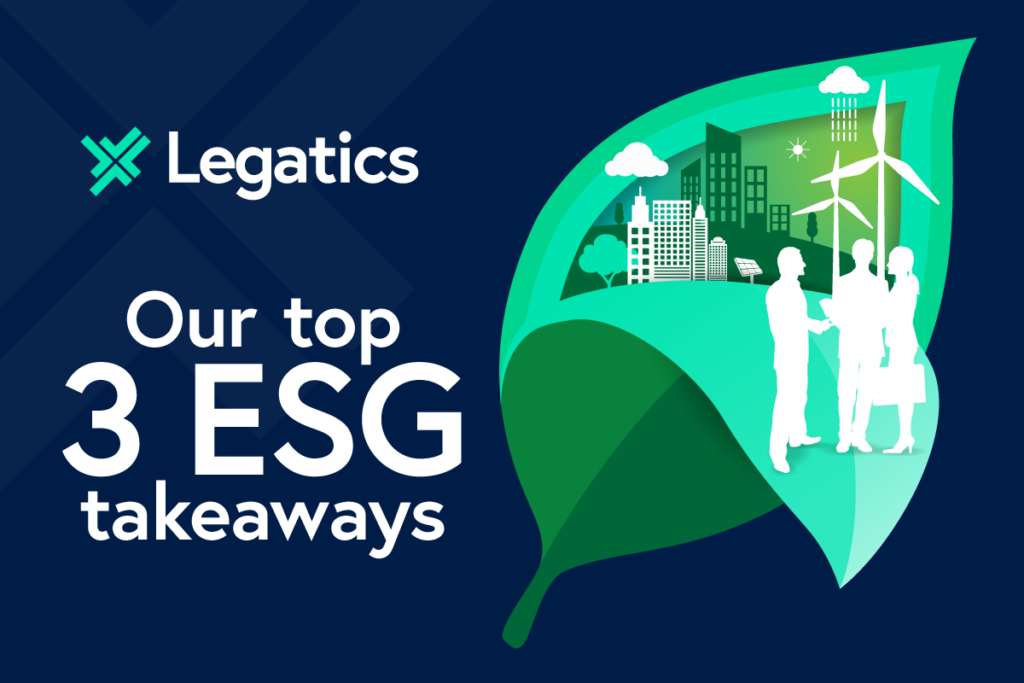We reflect on our three key ESG takeaways to date – inspired by COP27
Sustainability – across people, planet and profit – is an ongoing conversation within the Legatics team. As an organization, we’re striving for a more sustainable future which can be achieved not only with smarter technology, but also through greater awareness of the environment we operate in and how we impact it. We’re working toward our ESG goals as other organizations are also picking up speed, including the law firms and corporates we work with. At the same time, we understand that progress can only be made when it’s seen in the context of the bigger, worldwide picture it’s part of.
At this year’s COP27, international leaders are meeting to discuss how they’ll limit the increase in global temperatures. The conference is focusing on “moving from pledges to implementation” of their current targets and plans to achieve them.
Moving ESG forward from intent into action is often difficult. In this article, we share three approaches that Legatics has adopted to transform our ESG pledges into reality. We hope you find them useful in progressing your own ESG strategy!
1) Take an impact-first approach to ESG strategy
ESG factors affect everything a business does. This makes it hard to know where to focus your efforts. Understanding how to prioritize ESG topics and your actions to improve them is essential. To help with this, think about where you can create the most impact in an efficient way by:
- Identifying the areas of ESG most relevant to your industry (using tools like the SASB materiality assessment);
- Finding out where your business is having a neutral or negative impact on ESG factors (by engaging with stakeholders, experts, research and data);
- Understanding what you can act on; and
- Not becoming bogged down in ESG strategy at the expense of actioning solutions.
Taking an impact-first approach will help you balance considerations across stakeholders and shareholders, without compromising action over short and long-term planning.
2) Direction is sometimes better than targets
Although data is important in ESG, it doesn’t mean everything you do needs to be target-driven. For us, focussing instead on direction has been helpful. Targets can, in fact, make things more difficult, for the following reasons:
- They’re static. What’s seen as sufficiently ‘sustainable’ isn’t fixed, but targets are. Targets require work to stay relevant. Direction can adapt more easily to internal and external needs as there’s no set point it’s tied to.
- They’re hard to decide on. Figuring out the right targets takes time. For example, you need to look at best practices within and beyond your industry, how they align with your company values, as well as availability of resources, etc. Having a direction to run in – even if you can’t see the finish line – can help you get the ball rolling quicker.
- They’re quickly forgotten about. When targets are reached, they’re in danger of being ‘ticked-off’ and becoming irrelevant. As directions are easier to establish and maintain, they encourage more active engagement with ESG issues to keep them front-of-mind.
This doesn’t mean that targets don’t have their advantages and they will, of course, help you measure success. However, it’s important to acknowledge that not having targets won’t automatically slow down progress.
3) Work with ESG strategy, not against it
ESG shouldn’t be a tick-box exercise that’s separate from your other work. Instead, it should be a lens through which business activities are viewed, or ‘a way of working’. If ESG isn’t properly integrated in your organization:
- You’ll struggle to embed ESG into your culture (which is essential for success); and
- Your impact on ESG initiatives will be lower.
ESG is not a one-size-fits-all framework. By treating ESG as a ‘how’ rather than a ‘what’, it will be easier to join up ESG factors with other business goals. After all, ESG exists to benefit – not disrupt – development, so we should view it in these terms for successful results.
Looking forward
COP27 is calling for leaders to declare how they’re going to achieve their ambitious emissions pledges. For Legatics, a ‘hit-the-ground-running’ approach to ESG has been essential to finding direction, creating impact and developing sustainable principles across everything we do. It’s easy to have big dreams when it comes to sustainability, but without the foundations to realize them, they’ll remain just that. Sharing our learnings and working with others in the ESG space will also be vital for making progress, which is our motivation behind this article.
To learn more about our approach to sustainability, read our ‘3 tips for navigating your sustainability journey’ blog, and for more about COP27, visit their website.







